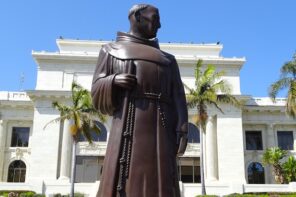Yesterday, researchers at John Jay College of Criminal Justice in New York released a 152-page report investigating causes and patterns of sexual abuse within the Catholic Church between 1950 and 2010. The report, initiated and authorized by the United States Conference of Catholic Bishops, investigated a number of potential factors contributing to a sharp peak of reported and documented abuse cases in the 1960s and 1970s, including social trends among ordination cohorts, changes in seminary curriculum, and psychological pathologies and social behaviors of abusive priests.
Its conclusion? The sixties—social movements and sex, drugs, and rock and roll—are to blame.
Study authors summarized their findings: “No single ‘cause’ of sexual abuse of minors by Catholic priests is identified as a result of our research. Social and cultural changes in the 1960s and 1970s manifested in increased levels of deviant behavior in the general society and also among priests of the Catholic Church in the United States. Organizational, psychological, and situational factors contributed to the vulnerability of individuals in this period of normative change.”
“The rise in abuse cases in the 1960s and 1970s was influenced by social factors in American society generally,” the report continued. “This increase in abusive behavior is consistent with the rise of other types of ‘deviant’ behavior, such as drug use and crime, as well as changes in social behavior, such as an increase in premarital sex and divorce.”
The report dismissed the all-male priesthood or priestly celibacy as factors in peaking abuse trends since these were “invariant” for the period of the study. It did find that priests were more likely to abuse if they had been abused as children, had been raised in families with negative attitudes toward sexuality (priests ordained in the 1940s and 1950s were particularly vulnerable here), and experienced rising stress levels at work and social isolation. Priests who reported engaging in sexual contact with adults of the same sex were not more likely to have abused children. (The report also attempts to discount abuse of children aged 11-14 as pedophilia, claiming instead that it technically qualifies as “ephebophilia”—the abuse of pubescent children—and thus it is inaccurate to characterize abusers as “pedophile priests.”)
Not surprisingly, the report was met immediately with dumbfounded disappointment and disbelief. The sixties? Really? Really?
Bob Hoatson, an ordained Catholic priest, abuse survivor, and founder of a nonprofit for survivors said on NPR that the Church tends “to look outside of themselves for the answers. The answers are inside. They’re internal… To say that the social revolution or Woodstock or any other external influence on the Catholic Church is the reason is just absurd.”
Hoatson and others point to the interior and intransparent culture of power in the Church hierarchy as a primary force in the persistence of child sexual abuse by priests.
There is a lot wrong with the John Jay report, including its attempt to argue on a historical pattern of abuse “peaking” in the 1970s based on only fifty years of data. Perhaps sexual abuse (including systematic predation on children) is endemic to any closed society or religious system. Perhaps the “peak” of documented abuse in the 1970s really reflects a peak in the reporting of that abuse decades later (in the 1980s and 1990s), thanks in no small part to the feminist movement’s emphasis on bearing witness to and ending sexual abuse. And perhaps it was this increased reporting of abuse that finally led to some deterrence of sexual abuse by priests and some minor adjustments to Church policy.
That’s right, I’m saying the Church should thank the social movements of the 1960s and 1970s—not blame them.
Imagine if the Catholic Church commissioned a report not by criminologists and psychologists focused on pinning down the causes of “deviance” but rather by a panel of theologians and ecclesiastical leaders from a broad interfaith spectrum. Imagine if the Catholic Church (and all churches with systematic abuse issues) had put everything—everything—on the table for examination, including its own internal structure, its accountability mechanisms, its commitment to a celibate, all-male priesthood, its systematic exclusion and devaluation of women. That would represent a truly substantial commitment to the well-being of children.
As it is, this report is evidence of a large church prioritizing the interests of powerful, large institutions over the rights of children to security and freedom from abuse. It is an 152-page millstone (as in Luke 17:2) hung about the neck of organized religion.




